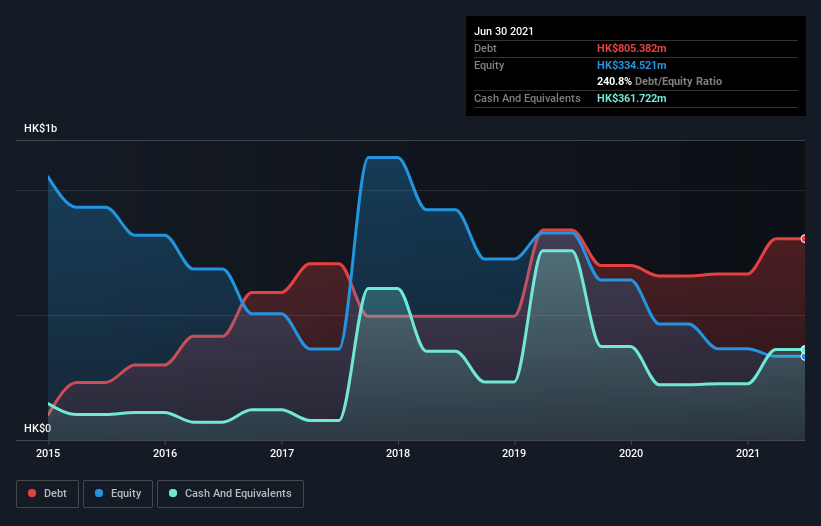Is i-CABLE Communications (HKG:1097) Weighed On By Its Debt Load?

Legendary fund manager Li Lu (who Charlie Munger backed) once said, 'The biggest investment risk is not the volatility of prices, but whether you will suffer a permanent loss of capital.' So it seems the smart money knows that debt - which is usually involved in bankruptcies - is a very important factor, when you assess how risky a company is. Importantly, i-CABLE Communications Limited (HKG:1097) does carry debt. But should shareholders be worried about its use of debt?
When Is Debt A Problem?
Debt assists a business until the business has trouble paying it off, either with new capital or with free cash flow. If things get really bad, the lenders can take control of the business. However, a more usual (but still expensive) situation is where a company must dilute shareholders at a cheap share price simply to get debt under control. By replacing dilution, though, debt can be an extremely good tool for businesses that need capital to invest in growth at high rates of return. The first thing to do when considering how much debt a business uses is to look at its cash and debt together.
See our latest analysis for i-CABLE Communications
What Is i-CABLE Communications's Net Debt?
The image below, which you can click on for greater detail, shows that at June 2021 i-CABLE Communications had debt of HK$805.4m, up from HK$655.5m in one year. However, because it has a cash reserve of HK$361.7m, its net debt is less, at about HK$443.7m.

How Strong Is i-CABLE Communications' Balance Sheet?
Zooming in on the latest balance sheet data, we can see that i-CABLE Communications had liabilities of HK$749.1m due within 12 months and liabilities of HK$580.2m due beyond that. On the other hand, it had cash of HK$361.7m and HK$100.5m worth of receivables due within a year. So it has liabilities totalling HK$867.1m more than its cash and near-term receivables, combined.
The deficiency here weighs heavily on the HK$570.8m company itself, as if a child were struggling under the weight of an enormous back-pack full of books, his sports gear, and a trumpet. So we definitely think shareholders need to watch this one closely. At the end of the day, i-CABLE Communications would probably need a major re-capitalization if its creditors were to demand repayment. The balance sheet is clearly the area to focus on when you are analysing debt. But it is i-CABLE Communications's earnings that will influence how the balance sheet holds up in the future. So when considering debt, it's definitely worth looking at the earnings trend. Click here for an interactive snapshot.
Over 12 months, i-CABLE Communications made a loss at the EBIT level, and saw its revenue drop to HK$1.0b, which is a fall of 6.8%. We would much prefer see growth.
Caveat Emptor
Importantly, i-CABLE Communications had an earnings before interest and tax (EBIT) loss over the last year. Its EBIT loss was a whopping HK$233m. Considering that alongside the liabilities mentioned above make us nervous about the company. We'd want to see some strong near-term improvements before getting too interested in the stock. Not least because it had negative free cash flow of HK$82m over the last twelve months. That means it's on the risky side of things. The balance sheet is clearly the area to focus on when you are analysing debt. However, not all investment risk resides within the balance sheet - far from it. Be aware that i-CABLE Communications is showing 2 warning signs in our investment analysis , and 1 of those is potentially serious...
At the end of the day, it's often better to focus on companies that are free from net debt. You can access our special list of such companies (all with a track record of profit growth). It's free.
Valuation is complex, but we're here to simplify it.
Discover if i-CABLE Communications might be undervalued or overvalued with our detailed analysis, featuring fair value estimates, potential risks, dividends, insider trades, and its financial condition.
Access Free AnalysisThis article by Simply Wall St is general in nature. We provide commentary based on historical data and analyst forecasts only using an unbiased methodology and our articles are not intended to be financial advice. It does not constitute a recommendation to buy or sell any stock, and does not take account of your objectives, or your financial situation. We aim to bring you long-term focused analysis driven by fundamental data. Note that our analysis may not factor in the latest price-sensitive company announcements or qualitative material. Simply Wall St has no position in any stocks mentioned.
Have feedback on this article? Concerned about the content? Get in touch with us directly. Alternatively, email editorial-team (at) simplywallst.com.
About SEHK:1097
i-CABLE Communications
An investment holding company, provides integrated communications services in Hong Kong.
Slight and slightly overvalued.
Market Insights
Community Narratives



